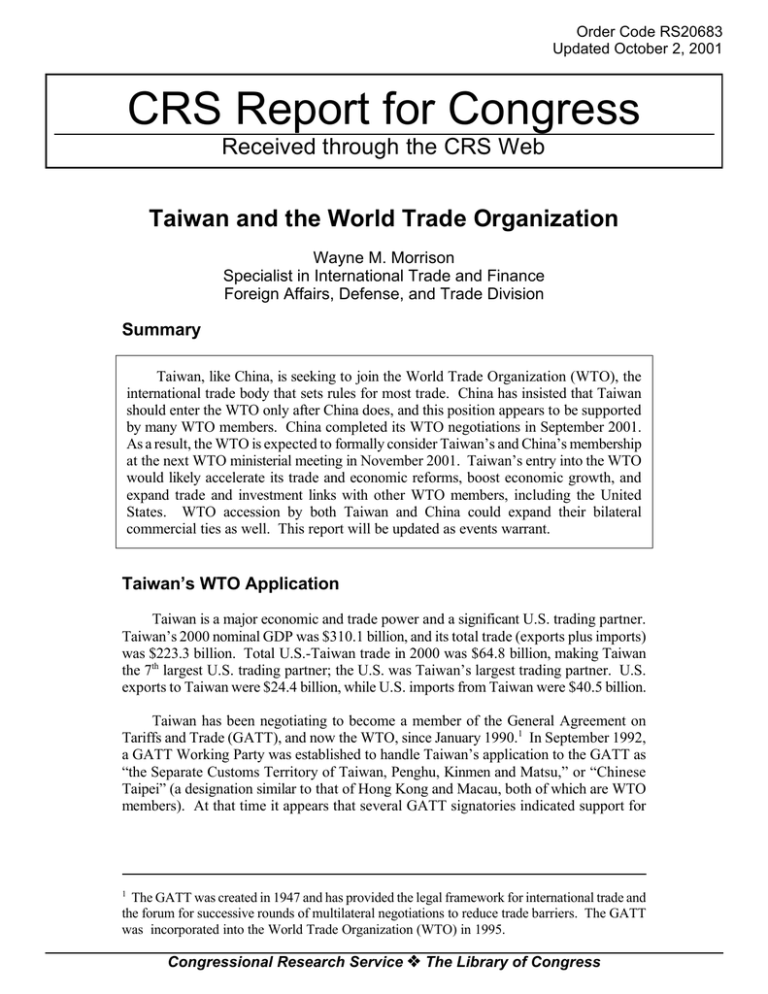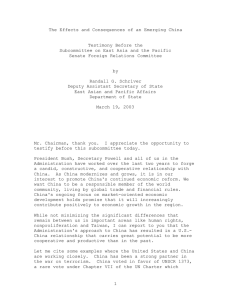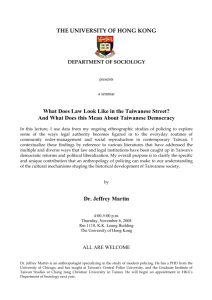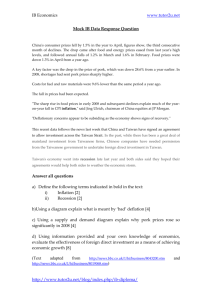CRS Report for Congress Taiwan and the World Trade Organization
advertisement

Order Code RS20683 Updated October 2, 2001 CRS Report for Congress Received through the CRS Web Taiwan and the World Trade Organization Wayne M. Morrison Specialist in International Trade and Finance Foreign Affairs, Defense, and Trade Division Summary Taiwan, like China, is seeking to join the World Trade Organization (WTO), the international trade body that sets rules for most trade. China has insisted that Taiwan should enter the WTO only after China does, and this position appears to be supported by many WTO members. China completed its WTO negotiations in September 2001. As a result, the WTO is expected to formally consider Taiwan’s and China’s membership at the next WTO ministerial meeting in November 2001. Taiwan’s entry into the WTO would likely accelerate its trade and economic reforms, boost economic growth, and expand trade and investment links with other WTO members, including the United States. WTO accession by both Taiwan and China could expand their bilateral commercial ties as well. This report will be updated as events warrant. Taiwan’s WTO Application Taiwan is a major economic and trade power and a significant U.S. trading partner. Taiwan’s 2000 nominal GDP was $310.1 billion, and its total trade (exports plus imports) was $223.3 billion. Total U.S.-Taiwan trade in 2000 was $64.8 billion, making Taiwan the 7th largest U.S. trading partner; the U.S. was Taiwan’s largest trading partner. U.S. exports to Taiwan were $24.4 billion, while U.S. imports from Taiwan were $40.5 billion. Taiwan has been negotiating to become a member of the General Agreement on Tariffs and Trade (GATT), and now the WTO, since January 1990.1 In September 1992, a GATT Working Party was established to handle Taiwan’s application to the GATT as “the Separate Customs Territory of Taiwan, Penghu, Kinmen and Matsu,” or “Chinese Taipei” (a designation similar to that of Hong Kong and Macau, both of which are WTO members). At that time it appears that several GATT signatories indicated support for 1 The GATT was created in 1947 and has provided the legal framework for international trade and the forum for successive rounds of multilateral negotiations to reduce trade barriers. The GATT was incorporated into the World Trade Organization (WTO) in 1995. Congressional Research Service ˜ The Library of Congress CRS-2 allowing Taiwan to join the GATT only after China did. It appears that this position is currently supported by several WTO members.2 The Taiwanese government has made accession to the WTO a top priority and has taken a number of steps in recent years to remove a wide variety of tariff and non-tariff barriers to prepare for WTO membership. In addition, Taiwan has agreed to be treated as a developed economy in the WTO upon its accession, a designation that will require it to adopt stricter standards on trade than is required of developing economies. The U.S.-Taiwan WTO Trade Agreement Taiwan and the United States reached a bilateral WTO agreement in February 1998 providing immediate market access and phased-in commitments for U.S. exports of goods, services, and agricultural products to Taiwan.3 A U.S. Trade Representative (USTR) press release indicates that Taiwan would liberalize trade in the following areas: ! Tariffs. Overall average tariffs would be reduced below 5% (from a current average level of 8.2%), with about two-thirds of the tariff reductions made upon accession. Taiwan agreed to join all Uruguay Round zero-for-zero initiatives, by eliminating all tariffs on paper, pharmaceuticals, medical equipment, construction equipment, steel, toys, furniture, agriculture equipment, civil aircraft, and distilled spirits. Taiwan has participated in the Information Technology Agreement (ITA) to eliminate tariffs on information technology products. Taiwan also agreed to participate in the WTO Chemical Harmonization Initiative. ! Automotive Products. Taiwan would sharply cut tariffs on imported autos, decrease the commodity tax on U.S. vehicle imports, eliminate an existing 9% subsidy on automobile components designed in Taiwan; remove a 50% local content requirement for auto parts, and make regulatory changes that would allow foreign companies to both lease vehicles and operate used car businesses. ! Government Procurement. Taiwan agreed to join the WTO Government Procurement Agreement, which would open its procurement markets to a wide range of U.S. products, including power-generating, transport and power transmission services. Taiwan would implement a new, more fair and transparent, contract and dispute resolution system regarding government contracts. 2 This informal agreement appears to have been taken due to political concerns over offending China, which views Taiwan as part of China. 3 As a “down payment” for eventual WTO membership, Taiwan agreed to lower many tariffs, and remove various non-tariff barriers, on a number of industrial goods, agricultural products, and services prior to its entry into the WTO. According to the USTR, many of these reductions were made according to government administrative orders and must be renewed annually until Taiwan enacts permanent reductions upon joining the WTO. CRS-3 ! Services. Upon WTO accession, Taiwan would open completely a number of service sectors, including professional services (architects, accountants, engineers, lawyers), audiovisual services, express delivery services, advertising, computer services, construction, wholesale and retail distribution, franchising, and environmental services. Taiwan also agreed to allow U.S. and other foreign companies to hold a controlling interest in Taiwan communications companies, and remove various barriers for telecommunication services in Taiwan. Finally, Taiwan agreed to provide substantially full market access and national treatment in the full range of financial services, such as banking, insurance, and securities. ! Agriculture. Taiwan agreed to immediately liberalize previously closed markets for pork, poultry, and variety meats and to make additional liberalization of such products after WTO accession. Taiwan also committed to begin the process of opening its rice market and to open fully markets for pork, variety meats and poultry to all WTO members upon accession by phasing out its tariff rate quota system. The agreement also called for significant immediate tariff reductions on a broad range of U.S. agricultural products, including potato products, pears, grapes, grapefruit, sunflower oil, and soup.4 Taiwan’s accession to the WTO could result in significant new trade and investment opportunities for U.S. firms. Taiwan would reduce tariffs on 3,470 industrial products and 1,021 agriculture products, with sharp reductions in many import sectors where high tariffs are maintained (such as autos and various agricultural products).5 In addition, many existing non-tariff barriers and trade distorting measure (such as subsidies) would be reduced or eliminated, and protection of intellectual property rights would be improved. Finally, the United States would be able to use the WTO trade dispute resolution process to ensure that Taiwan abided by its WTO commitments. A 1999 study by Dr. Greg Mastel (at the International Trade Studies at the Center for National Policy) examined the effects WTO accession would have on Taiwanese imports of six major agricultural and industrial sectors (fruits and vegetables, meat products, automobiles, auto parts, semiconductors, and textile and apparel), and concluded that combined imports of these products would likely rise by an additional $5.5 billion (a significant level of which would come in the auto sector) over the course of nine years (the time period in which tariff and non-tariff reductions are phased in). The study concluded that, taking in consideration the full range of import categories, this figure would probably increase by nearly ten fold ($55 billion).6 The United States is Taiwan’s second largest source of imports (after Japan), accounting for 17.8% of Taiwan’s imports (1999), and thus would likely be a major beneficiary of Taiwan’s WTO accession. Taiwan’s economy 4 USTR Press Release, February 20, 1998. 5 Taiwan Board of Foreign Trade, Taiwan’s WTO Accession Package, available at [http://www.moeaboft.gov.tw/english/page31.htm]. 6 Mastel, Greg. Taiwan in the WTO: An Economic and Policy Analysis, October 6, 1999, available at [http://www.taipei.org/un/wto0223.htm]. CRS-4 would also likely be enhanced by its WTO membership through gains in efficiency resulting from further economic and trade reforms, and by increased trade. Current Status of Taiwan’s WTO Application Taiwan has completed bilateral WTO market access agreements with each of the 26 WTO members that have requested bilateral negotiations (although Hong Kong has not yet officially signed its bilateral agreement with Taiwan) and appears to have nearly completed talks with the WTO Working Party handling its accession.7 According to a Taiwanese government document: As for multilateral progress, we have already held ten Working Party meetings in Geneva. As a result of the series of meetings, we have reached conclusion on all substantive issues and hope for the adoption of the Working Party Report and the Accession Protocol in the next Working Party meeting, in order to move the accession process forward to the General Council.8 As noted, Taiwan’s accession to the WTO has been be tied to the completion of China’s requirements to enter the WTO. On September 13, 2001, China concluded a WTO bilateral trade agreement with Mexico, the last of the original 37 WTO members that had requested such an accord. On September 17, 2001, the WTO Working Party handling China’s WTO application announced that it resolved all outstanding issues regarding China’s WTO accession. On September 18, 2001, The WTO Working Party handling Taiwan’s membership announced that it had completed its negotiations. The WTO is expected to formally approve the entry of China and Taiwan at the next WTO Ministerial Conference in November 2001. Afterwards, China and Taiwan can officially join the WTO 30 days after they formally adopt the WTO agreements. WTO Director Mike Moore has indicated that the WTO would approve Taiwan’s WTO accession right after it approved China’s membership. He was quoted as saying: “I would expect China to go through and Chinese Taipei to come through shortly after – does it mean we break for coffee, tea, dinner or overnight? But it would happen around the same time.”9 U.S. Policy on Taiwan’s WTO Entry and Congressional Concerns U.S. officials have repeatedly stated that the United States supports Taiwan’s WTO accession based on its own merits. The issue of Taiwan’s WTO accession became a major issue during debate in the 106th Congress over H.R. 4444, a bill that would grant PNTR status to China upon its accession to the WTO. Several Members expressed concern that China might try to exert political influence over some WTO members (or take other 7 The 26 WTO members include South Africa, the Czech Republic, the Slovak Republic, El Salvador, Turkey, Colombia, Uruguay, Chile, South Korea, Australia, Japan, Iceland, Norway, Malaysia, Philippines, Thailand, Hungary, Mexico, New Zealand, Argentina, Singapore, the United States, the European Union, Canada, and Hong Kong. 8 Taiwan Board of Foreign Trade, Taiwan’s Accession to the World Trade Organization, January 2000 (available at [http://www.moeaboft.gov.tw]). 9 Muzi Lateline News, June 6, 2000, available at [http://www.lateline.muzi.net]. CRS-5 unspecified steps) to block Taiwan’s accession; many urged the Clinton Administration to restate its position on Taiwan’s WTO membership, and others made legislative proposals. In an August 31, 2000 letter to Senator Jon Kyl on U.S. policy toward’s Taiwan’s WTO accession, President Clinton stated that “China has made clear on many occasions, and at high levels, that it will not oppose Taiwan’s accession to the WTO.” However, the letter acknowledged that “China did submit language to their working party stating that “Taiwan is a separate customs territory of China,” but went on to state that it had “advised the Chinese that such language is inappropriate and irrelevant to the working and that we will not accept it.” In a letter (dated September 12, 2000) to Senators Thomas Daschle and Trent Lott, President Clinton stated: There should be no question that my Administration is firmly committed to Taiwan’s accession to the WTO, a point I reiterated in my September 8 meeting with President Jiang Zemin. Based on our New York discussions with the Chinese, I am confident we have a common understanding that both China and Taiwan will be invited to accede to the WTO under the language agreed to in 1992, namely as the Separate Customs Territory of Taiwan, Penghu, Kinmen and Matsu (referred to as “Chinese Taipei”). The United States will not accept any other outcome. Section 601 of H.R. 4444 (which was enacted into law on October 10, 2000, P.L.106-286) states that, immediately upon approval by the WTO General Council of China’s accession to the WTO, the U.S. representative to the WTO should request that Taiwan’s WTO accession be the next order of business, and that the United States should be prepared to aggressively counter any effort to block Taiwan’s accession. The Bush Administration has indicated its strong support for Taiwan’s WTO accession. In testimony before the House Ways & Means Committee on China’s NTR status, Assistant USTR Jeffrey A. Bader stated: We fully expect the WTO to approve Taiwan’s accession in the same time frame as China’s. As a major player in international trade and a new and thriving democracy, Taiwan deserves membership and a larger role in the international community. We have discussed our expectations on Taiwan’s accession thoroughly with all the concerned parties and are confident there is a consensus on this. WTO and China-Taiwan Commercial Ties Accession to the WTO by both Taiwan and China could have a significant effect on bilateral commercial ties. Despite the lack of direct economic and political links, ChinaTaiwan trade and investment have surged over the past 11 years. From 1990 to 2000, total bilateral trade rose from $5.2 billion to $31.2 billion. The cumulative value of Taiwanese investment in the mainland at the end of 2000 was over $26.4 billion (making Taiwan the 4th largest foreign investor in China). Taiwan has shifted much of its laborintensive, export oriented, industries to the mainland. However, most trade between China and Taiwan takes place indirectly via Hong Kong. While China is a major market for Taiwan’s exports ($25.0 billion in 2000), it is a relatively small source of its imports ($6.2 billion), mainly because Taiwan places significant restrictions on imports from China (especially products that might compete directly with Taiwanese-made goods). Taiwan also maintains restrictions on the amount and types of investment that are allowed to be CRS-6 made in China (although many investors seek to circumvent these restrictions by investing through off-shore companies). WTO membership for Taiwan and China could lead to direct trade links, the extension of mutual most-favored-nation (MFN), or non-discriminatory, treatment, a reduction in trade and investment restrictions by both parties (especially by Taiwan), and possibly the use by both parties of the WTO dispute resolution process to resolve trade disputes. On the other hand, Taiwan or China might choose (prior to their accession) to invoke Article 13 in the WTO, the non-application clause, against the other. If this occurred, the WTO agreements would not apply between the two economies. Additionally, Taiwan or China could decide at any point after accession to invoke Article 21 in the WTO, a provision that enables WTO members to suspend MFN treatment to another member for national security reasons. Both Chinese and Taiwanese government officials appear to have mixed views on closer economic integration. Each seems to think that closer economic ties gives them greater political leverage over the other to influence the relationship (e.g., Taiwan hopes such ties help to stabilize the relationship with the mainland and reduce the likelihood of a Chinese invasion, while China hopes such ties improve the chances for reunification with Taiwan and diminish the likelihood of Taiwan declaring independence). At the same time, however, each side seems concerned with becoming too dependent on cross-strait economic ties, since a disruption in that relationship could have serious economic consequences for both. Since 1996, the Taiwanese government has maintained a “no haste, be patient” policy, seeking to limit the level of Taiwanese investment with the mainland for security reasons.10 However, economic conditions have deteriorated sharply in Taiwan during 2001. Due largely to the economic slowdown in the United States and other major world economies, Taiwanese exports (especially high-technology products) are down sharply, and unemployment has hit a record high (5.2% in August 2001).11 Taiwan’s growing economic crisis has led several Taiwanese government officials to call for an abandonment of the “no haste, be patient” policy as a means to reviving the economy. In August 2001, Taiwanese President Chen Shui-bian endorsed the replacement of the “no haste, be patient” policy with an “active opening, effective, management” policy, which would relax current restrictions on investment in the mainland, establish direct trade, transportation and communication links with China, and gradually allow mainland investment in Taiwan. However, the issue of closer economic links with the mainland remains a contentious issue in Taiwan. Supporters of closer economic integration argue that Taiwanese firms must take advantage of China’s growing demand for goods and services, as well as its abundant low-cost labor, in order to stay competitive in world markets. Opponents of closer ties contend that such policies will accelerate the transfer of Taiwanese firms to the mainland, leading to a hollowing out of core industries, and raising the level of unemployment in Taiwan. 10 The policy has been aimed at restricting investment of over $50 million as well as certain high-tech industries and infrastructure projects. 11 Taiwan’s economy is likely to be further damaged by the effects of the terrorist attacks against the United States on September 12, 2001.








